2021 Ford Explorer Review | What's new, prices, MPG, pictures

Most three-row family crossovers are just minivans in disguise. What's going on inside them matters far more than the oily bits – it's the number of cupholders that count, not cylinders. The 2021 Ford Explorer is different. Although certainly spacious and family friendly, the latest Explorer is for those who want their SUV to have guts. The standard 2.3-liter turbo engine pumps out more power and torque than its competitors' V6 engines, while bettering their fuel economy as well. The optional V6 engines, meanwhile, are turbocharged and obliterate everything else in the segment, topping out at 400 horsepower in the Explorer ST. Even the Explorer Hybrid puts an emphasis on performance. Basically, between those engines and the Explorer's rear-wheel-drive platform, there's nothing minivan about it.
Other strong suits include its vast cargo capacity and ample standard feature content, however, in most other regards, the Explorer is merely average for the segment. The Kia Telluride and Hyundai Palisade deliver higher-quality cabins with more passenger space (among many other talents). The Mazda CX-9 has the sort of car-like driving experience you might expect but won't get with the rear-drive Explorer. The Toyota Highlander Hybrid gets vastly better fuel economy than the Explorer Hybrid. The Lincoln Aviator actually costs less than the Explorer Platinum despite its stronger performance and far ritzier cabin.
We could go on, but in short, the Explorer is definitely worth a look, especially if getting an SUV with guts is appealing. Just make sure to look elsewhere as well.
What's new for 2021?
The Explorer was all-new last year, yet there are a number of small changes and updates made for 2021. The top trim levels receive "enhanced interior finishes," which sounds good in theory – the cabins of the pricey Limited, ST and Platinum were underwhelming. There are also some minor feature changes, most notably the XLT's standard heated front seats and newly optional Appearance Package that adds various bits of dark gray trim. Mechanical updates include upgraded brakes for the ST and transmission paddle shifters added as standard to the Limited Hybrid, ST and Platinum. Finally, there are multiple new wheel choices and some different paint choices.
However, the most significant difference is actually the price. The base price drops by $540, while savings on the various upper trim levels are between $2,000 and $4,000.
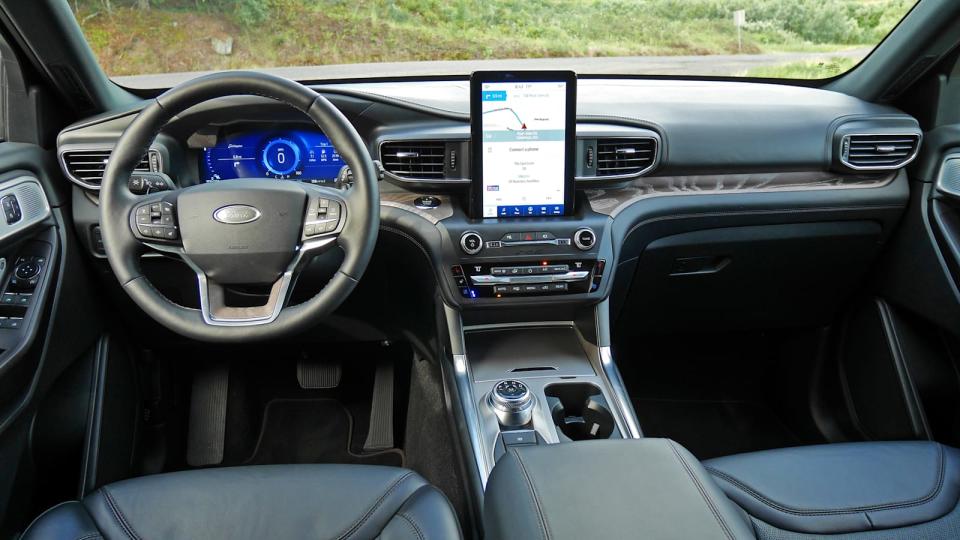
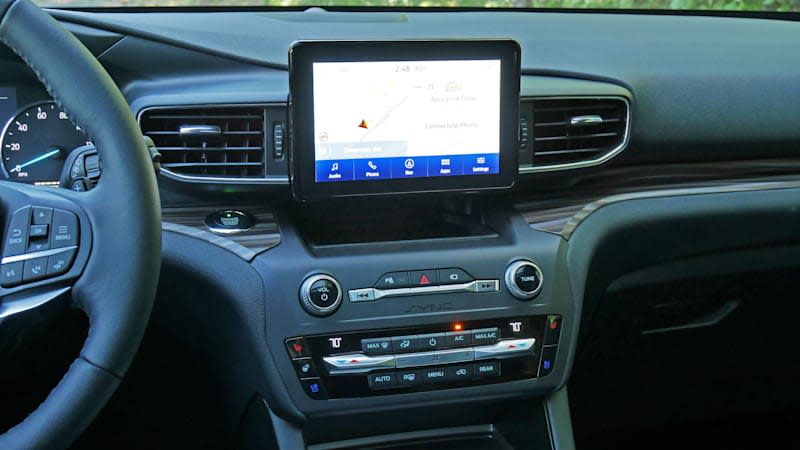
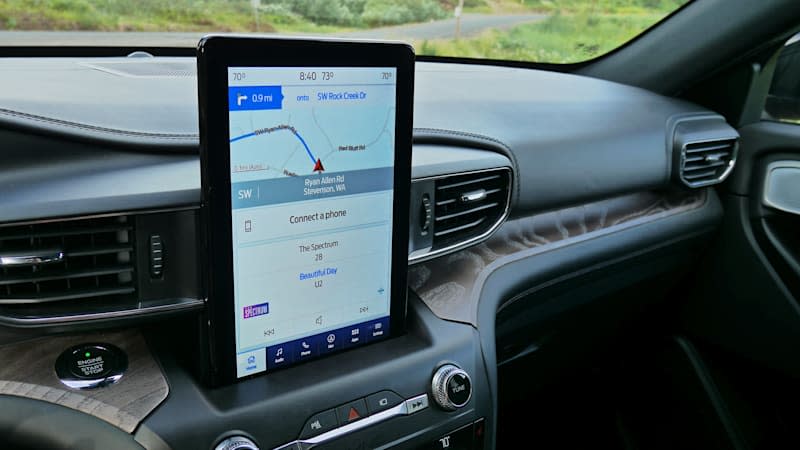
What are the Explorer interior and in-car technology like?
The Explorer has a more visually interesting cabin than what you'll find in a Dodge Durango, Honda Pilot or Subaru Ascent, but the unremarkable quality of its plastics is a real letdown. Ford apparently upgraded some finishes in the top trim levels for 2021, but we haven't seen the results in person yet. Here's hoping those finishes include something better than the "wood" that was present for 2020. In any event, you'll undoubtedly find far nicer cabins in terms of quality, design and value for your money in the Kia Telluride, Hyundai Palisade and Toyota Highlander.
Every Explorer comes standard with Ford's Sync3 infotainment interface. It responds well to inputs and swipe gestures, icons are easily read and pressed, and feature content is typically robust for this segment. That includes Android Auto and Apple CarPlay, although we've found that too many of their functions are locked out while in motion. We ended up using Sync3's native controls for navigation or playing music from a smartphone.
Now, while every Explorer has Sync3, the screen that controls it differs. The standard 8-inch touchscreen is easy to see and reach, and we like the extra smartphone-holding bin below it. That disappears with the 10.1-inch vertically oriented touchscreen, which is optional only on Platinum and ST, and doesn't improve functionality as you might expect. The Platinum's 12.3-inch digital instrument panel is far more successful and even changes its design based on the one of seven possible drive modes selected.
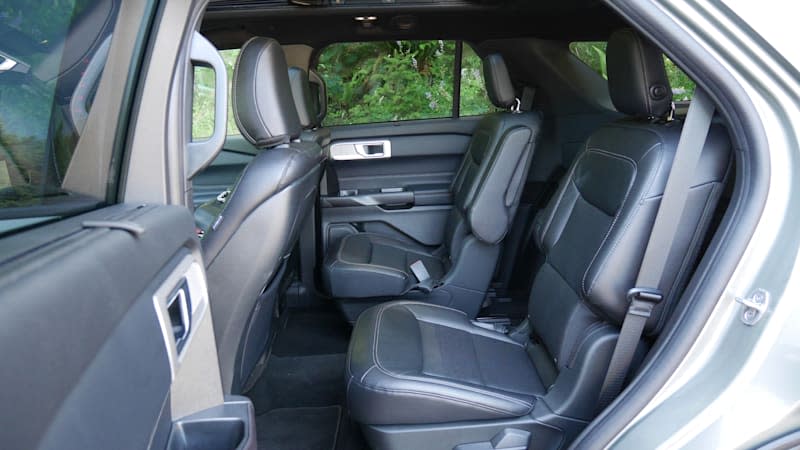


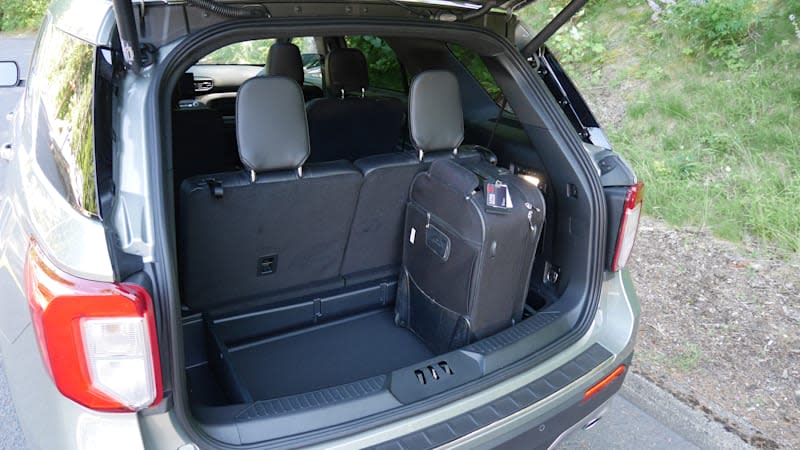
How big is the Explorer?
The current Explorer is larger than both its predecessor and most competitors. At 198.8 inches long, only the gargantuan Chevy Traverse is larger. Thankfully, it doesn't feel that big when behind the wheel.
Inside, the Explorer's dimensions indicate it has more second- and third-row legroom than all of its three-row competitors except the Traverse. However, in person we've found it to be less spacious than its dimensions would indicate, especially in the third row. While there's tons of headroom back there, it's largely the result of a low-mounted seat. So while there's literally more space between rows, your passengers (even kids) are less likely to be comfortable since their butts will be too close to the ground and their legs less supported. They'll be happier in a Traverse, Kia Telluride or Hyundai Palisade.
The cargo area is as good as its dimensions would indicate, however. Thanks to a removable floor panel, there is more space behind the raised third row than any competitor. The differences in maximum cargo space (all rows lowered) between competitors are negligible, but those extra cubes behind the way-back could mean the difference between bringing all your luggage, buying a roof box or making someone sit with a duffle bag on their lap for three hours.
What are the Explorer fuel economy, performance and towing specs?
Here is where the 2021 Ford Explorer really shines. Standard on the base, XLT and Limited trims is a 2.3-liter turbocharged inline-four that produces 300 horsepower and 310 pound-feet of torque. That's considerably better than the naturally aspirated V6 engines found in most competitors. A 10-speed automatic and rear-wheel drive are standard, but all-wheel-drive is optional. Fuel economy matches the current segment best with rear-wheel drive: 21 mpg city, 28 mpg highway and 24 mpg combined. It lowers to an equally competitive 20/27/23 with AWD.
Standard on the Platinum is a 3.0-liter turbocharged V6 good for 365 hp and 380 lb-ft of torque – that blows away anything offered by a competitor apart from the V8-powered Dodge Durango. That doesn't come close to the Platinum's fuel economy, however, which is 18/24/20 with standard all-wheel drive. It too has a 10-speed automatic.
The Explorer ST gets an enhanced version of the same engine good for 400 hp and 415 lb-ft of torque. Ford says it'll go from zero to 60 mph in 5.5 seconds, which is certainly quick, but not as quick as we'd expect given its power and the performance of certain competitors. Fuel economy is apparently the same as the Platinum, but we strongly suspect it would be much lower in the real world than in the EPA's laboratory given the power discrepancy.
Finally, the Explorer Hybrid pairs a 3.3-liter naturally aspirated V6 to an electric motor and a lithium-ion battery pack under the passenger-side cabin. Its total output is 318 hp. EPA-estimated fuel economy stands at 27 mpg city, 29 mph highway and 28 mpg combined with rear-wheel drive. It lowers to 23 mpg city, 26 mph highway and 25 mpg combined with all-wheel drive. This is admittedly underwhelming as according to those same EPA estimates, you'd only save about $100 on average per year by going with the hybrid instead of the standard engine. Also, for comparison, the all-wheel-drive 2021 Toyota Highlander Hybrid gets 35 mpg combined. That's as big a difference as it seems.
That said, Ford has put a priority on performance, even with the hybrid. You can see that with towing capacity, which stands at 5,000 pounds for the Hybrid. The Highlander has 72 fewer horses and can only tow 3,500 pounds. For the non-hybrid Explorers, towing goes up to 5,300 for the 2.3-liter and 5,600 for the 3.0-liter engines. Both figures are better than average for the segment.

 Yahoo Autos
Yahoo Autos 

